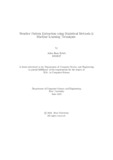| dc.contributor.advisor | Ashraf, Faisal Bin | |
| dc.contributor.advisor | Mostakim, Moin | |
| dc.contributor.author | Habib, Adria Binte | |
| dc.date.accessioned | 2021-09-14T07:20:17Z | |
| dc.date.available | 2021-09-14T07:20:17Z | |
| dc.date.copyright | 2021 | |
| dc.date.issued | 2021-06 | |
| dc.identifier.uri | http://hdl.handle.net/10361/15010 | |
| dc.description | This thesis is submitted in partial fulfillment of the requirements for the degree of Bachelor of Science in Computer Science and Engineering, 2021. | en_US |
| dc.description | Cataloged from PDF version of thesis. | |
| dc.description | Includes bibliographical references (page 26-28). | |
| dc.description.abstract | It is known to all that the existence of life is highly dependent on the weather.
Due to the unfavorable condition of current global weather the existence of life is in
danger already. Since for the existence of lives a livable environment which lies in
the weather is very much intrinsic, it should be taken care of before it is too late.
This is the main context of this research. The goal of this research is to find out
the future condition of temperature of some particular places of California using
machine learning and statistical methods and compare which place will be more
livable after two years. Currently, one of the most alarming issue in the world is the
global warming. The effect of global warming is increasing rapidly every day without
any sign of slowing down. As a result of this, it’s very concerning and important
to understand the state of the temperature of the world and the route it will take
in the future. As such, the objective of this reseach is to predict the temperature
conditions of the future. The research starts by collecting data of few select areas
in california and hence, extracted data from 14 stations of california. The data was
then fed to the ARIMA model to find the future trend with the respective ARIMA
orders and other paremeters per station. The research has successfully identified
the trend of the next 730 days (2 years) while considering the errors that the model
creates. Furthermore, the research tried to identify the most favorable place to
live, in california, by comparing the RMSE of the different stations by comparing
the distance between the favorable human ambient temperature of 70◦F with the
results that we got from the prediction. As such, the ‘Miramar’ station gave the
least RMSE value of 10.7824 while the ‘lake Arrowhead’ gave the worst RMSE
of 24.3605. From these RMSE values and also the learning curves it was decided,
the most favorable place to live around was the ‘Miramar’ station, while ‘lake
Arrowhead’ station was the worst in terms of favourable temperature for humans. | en_US |
| dc.description.statementofresponsibility | Adria Binte Habib | |
| dc.format.extent | 55 pages | |
| dc.language.iso | en | en_US |
| dc.publisher | Brac University | en_US |
| dc.rights | Brac University theses are protected by copyright. They may be viewed from this source for any purpose, but reproduction or distribution in any format is prohibited without written permission. | |
| dc.subject | Statistical Methods | en_US |
| dc.subject | Machine Learning | en_US |
| dc.subject | Weather | en_US |
| dc.subject | Prediction | en_US |
| dc.subject | ARIMA | en_US |
| dc.subject | Trend Analysis | en_US |
| dc.subject.lcsh | Machine Learning | |
| dc.title | Weather Pattern Extraction using Statistical Methods & Machine Learning Techniques | en_US |
| dc.type | Thesis | en_US |
| dc.contributor.department | Department of Computer Science and Engineering, Brac University | |
| dc.description.degree | B. Computer Science | |

